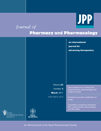Encapsulation of vinorelbine into cholesterol-polyethylene glycol coated vesicles: drug loading and pharmacokinetic studies
Abstract
Objectives Pegylated liposome formulations of vinorelbine with prolonged circulation half-life (t½) are desirable. However, DSPE-PEG could affect vinorelbine loading into vesicles due to electrostatic interactions. To resolve this problem, chol-PEG was used to prepare pegylated liposomal vinorelbine and the factors affecting drug loading and plasma pharmacokinetics were investigated.
Methods Vinorelbine was loaded into liposomes using a novel triethylamine 5-sulfosalicylate gradient. The effects of cholesterol and chol-PEG on drug loading were investigated. Pharmacokinetic studies were performed in normal KunMing mice treated with different liposomal vinorelbine formulations. To clarify the effects of chol-PEG on membrane permeability, drug release experiments were performed based on the fluorescence dequenching phenomenon of a fluorescence marker.
Key findings In contrast to DSPE-PEG, even at high PEG grafting density (∼8.3 mol%), chol-PEG had no effect on vinorelbine loading into HSPC/cholesterol (3 : 1, mass ratio) vesicles. However, for the formulations with low cholesterol content (HSPC/cholesterol 4 : 1), loading efficiency decreased with increasing chol-PEG content. In vivo, the vinorelbine t½ of low cholesterol formulations decreased with increasing chol-PEG content, but for high cholesterol liposomes, the maximum vinorelbine t½ was achieved at ∼3 mol% chol-PEG grafting density. The resulting vinorelbine circulation t½ was ∼9.47 h, which was greater than that of non-pegylated liposomes (∼5.55 h). Drug release experiments revealed that chol-PEG might induce membrane defects and concomitant release of entrapped marker, especially at high chol-PEG density.
Conclusions Through the investigation of the effects of chol-PEG and cholesterol, an optimum pegylated liposomal vinorelbine formulation with prolonged t½ was achieved. In plasma, the membrane defect induced by chol-PEG may counteract the long circulation characteristics that chol-PEG afforded. When these two opposite effects reached equilibrium, the maximum vinorelbine t½ was achieved.




